Imperial Tombs of Hué | Which Ones to Visit and Why?
Best Tombs to Visit in Hué
Hué is the former imperial capital of Vietnam, a fascinating blend of history, architecture, and a peaceful atmosphere. But beyond the Imperial Citadel and the Perfume River, what truly stood out to me during my trip were the emperors’ tombs.
Why? Because each tomb tells a different story, with styles ranging from simple and elegant to extravagant and opulent. Some are nestled in nature, while others showcase grandiose luxury. These sites offer a unique insight into Vietnam’s imperial past, away from the crowded streets of the old town.
In this article, I’ll share my personal experience and tips on visiting the most beautiful tombs of Hué, helping you avoid tourist traps and make the most of each site.
Minh Mang Tomb – The Must-See Site
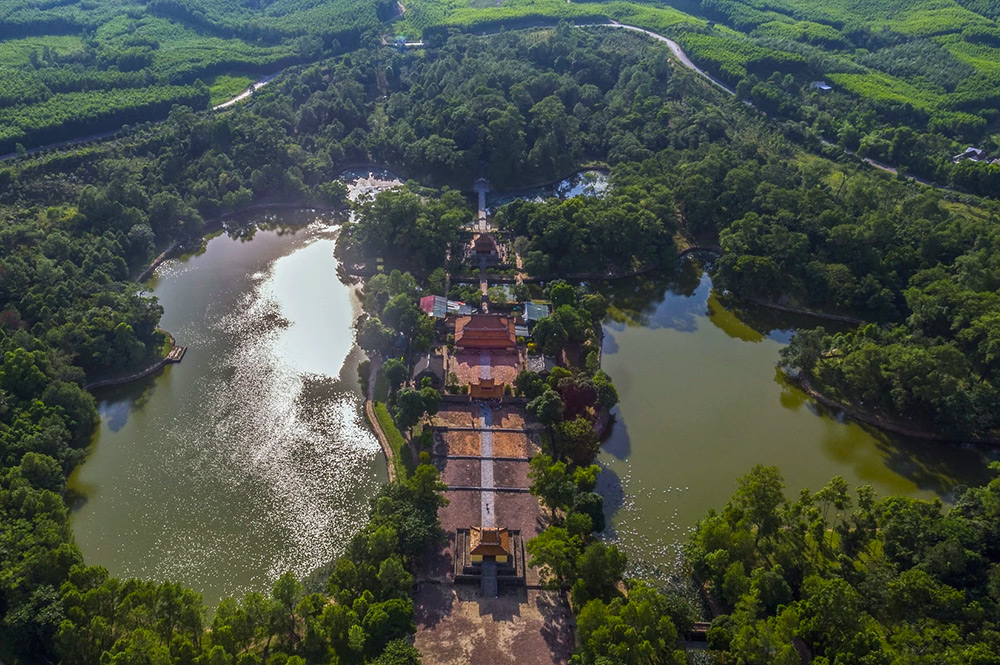
If I had to choose one imperial tomb for its balance and atmosphere, it would undoubtedly be Minh Mang’s tomb. Located slightly outside the center of Hué, this site offers a perfect harmony of architecture, nature, and spirituality.
From the entrance, I was struck by the impressive symmetry of the place. Unlike other tombs, everything here is designed for peace and meditation: lotus-filled ponds, elegant stone bridges, and a series of pavilions that gently lead to the emperor’s tomb. No excessive gold decorations or overwhelming statues-just a simple, serene setting, true to Minh Mạng’s Confucian values.

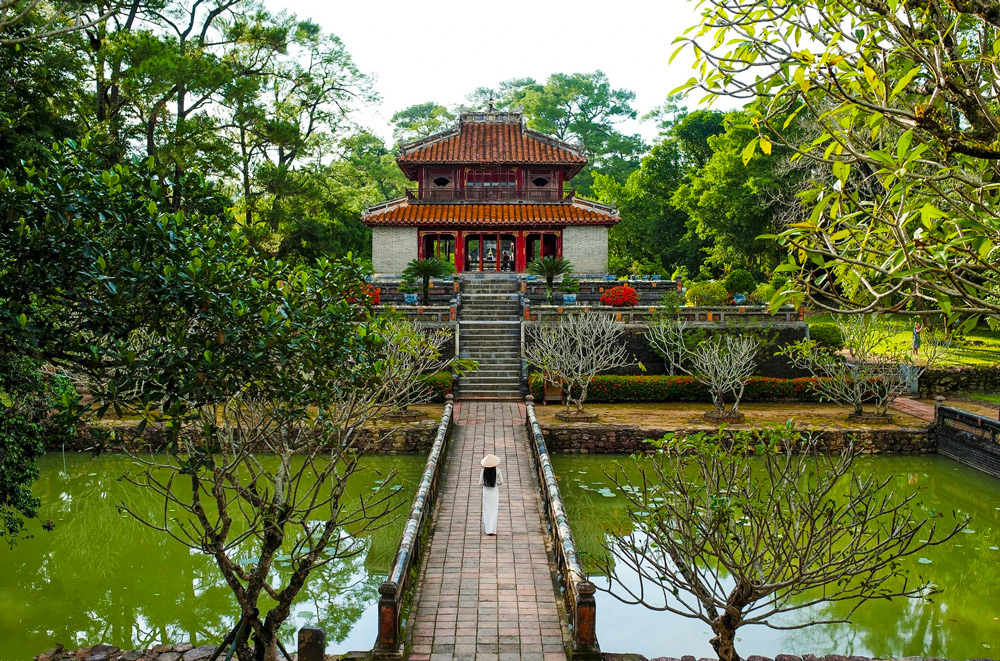

My take: The atmosphere is incredible. Covering 18 hectares, it’s the largest of all the tombs and also the most photogenic-but be prepared for lots of tourists.
Things to Know Before You Go
- Location: About 12 km from Hué’s center (accessible by scooter or taxi).
- Opening hours: 7:00 AM to 5:30 PM.
- Entrance fee: Around 150,000 VND (€5-6).
- Best time to visit: Early morning or late afternoon to avoid the heat and crowds.
Khai Dinh Tomb: Imperial Eccentricity

If Minh Mang symbolizes harmony and simplicity, Khai Dinh represents the exact opposite: opulence, a mix of styles, and an obsession with detail. This is undoubtedly the most visually striking tomb, but also the most controversial.
As soon as I arrived, I was struck by the austere and dark exterior. A monumental staircase, guarded by stone soldiers, leads to the top of the site. Under Hué’s scorching sun, the climb is tough, but the effort is well worth it once inside.
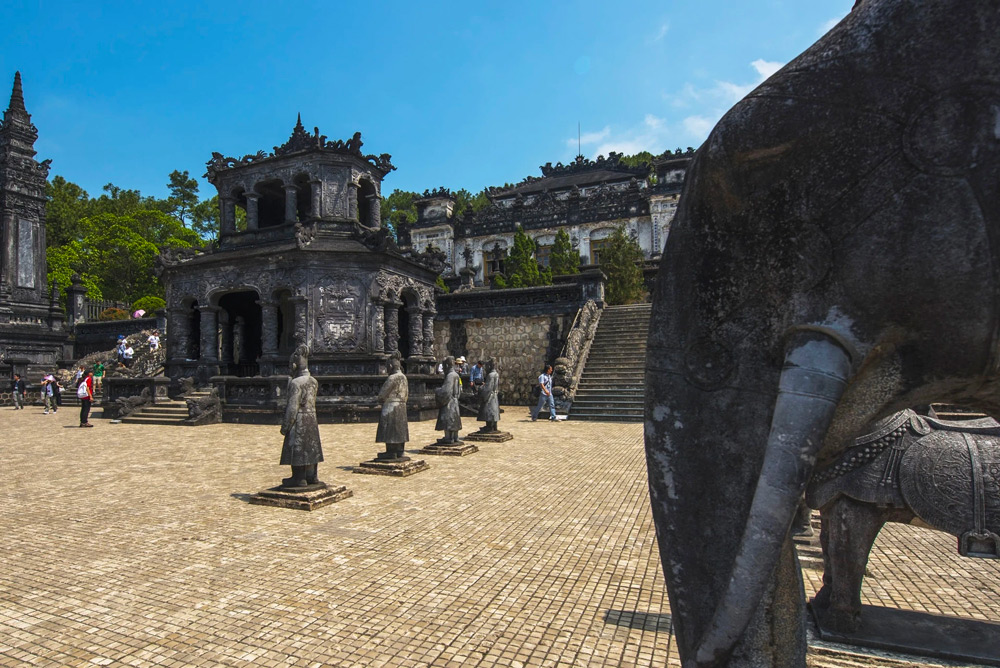

And then-visual overload: marble, dazzling porcelain mosaics, hand-painted ceilings… A baroque-like decor that contrasts sharply with the tomb’s plain exterior. The main chamber houses Khai Dinh’s golden sarcophagus, placed under a vaulted ceiling adorned with a relief of an imperial dragon. It’s clear the emperor wanted to impress-even if it meant overdoing it.
It’s a fascinating tomb, but very crowded. Lots of tour groups, lots of noise. Definitely worth seeing for its unique style and grandeur, but not the best place for a peaceful visit.
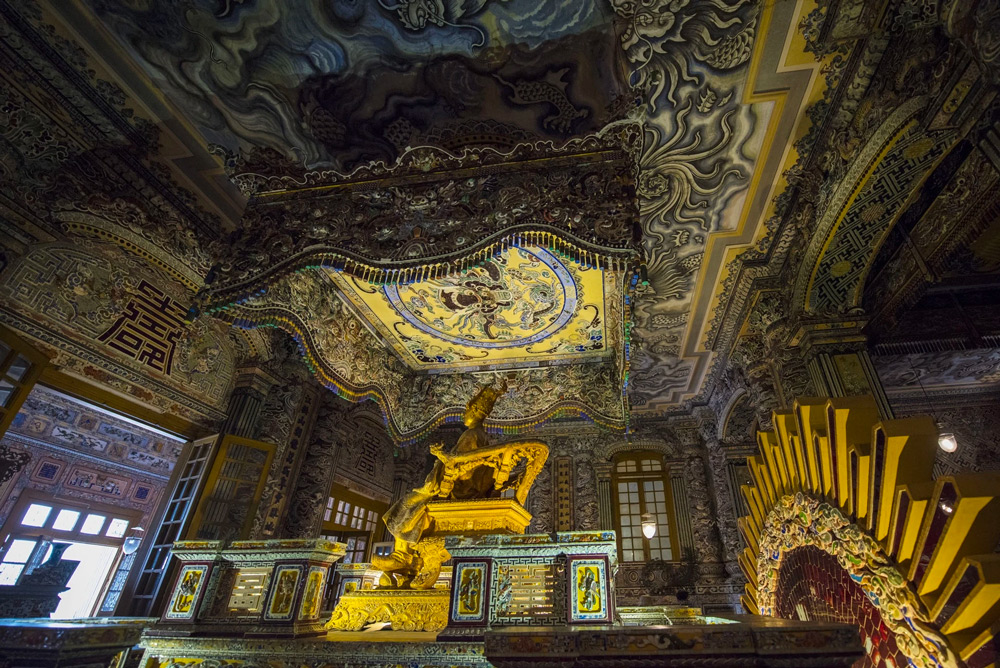
Things to Know Before You Go
- Location: About 10 km from Hué, on a hillside.
- Opening hours: 7:00 AM to 5:30 PM.
- Entrance fee: Around 150,000 VND.
- Best time to visit: Early morning, before the tourist buses arrive.
Tu Duc Tomb: A Peaceful Imperial Retreat

Unlike Khai Dinh’s tomb, where everything is extravagant, Tu Duc’s tomb is a haven of peace, nestled in the heart of a vast green park. More than just a mausoleum, it was an imperial residence where the emperor would come to relax and write poetry long before his death.
What struck me upon arrival was the sheer size of the site. There are beautifully carved wooden pavilions, a large lake surrounded by pine trees, and shaded pathways that almost make it feel like wandering through a giant Zen garden. The atmosphere is calm and soothing, a stark contrast to the busier imperial tombs.


Interesting fact: Tu Duc isn’t actually buried here! His real tomb is hidden somewhere around Hué, but its exact location remains a mystery-because all those who participated in his burial were executed to ensure the secret was never revealed. So, the tomb visible on-site is actually just a symbolic monument.
I loved the space and the peaceful atmosphere. You can easily spend over an hour wandering around, completely losing track of time. It’s the perfect spot if you want to escape the crowds and appreciate nature and traditional Vietnamese architecture.
Things to Know Before You Go
- Location: About 6 km south of Hué.
- Opening hours: 7:00 AM to 5:30 PM.
- Entrance fee: 150,000 VND, often included in a combo ticket with other sites.
- Best time to visit: Afternoon, when the light is softer and there are fewer visitors.
Gia Long Tomb: The Forgotten Emperor in the Wild

If you’re looking for an imperial tomb far from mass tourism, Gia Long’s tomb is a hidden gem. It is the first imperial tomb in Hué, built for the founder of the Nguyễn dynasty, yet it remains the least visited. Located deep in nature, away from the usual tourist routes, it offers a unique experience, blending exploration and historical immersion.
I was surprised by the vastness of the site and its wild, untouched atmosphere. Unlike Khai Dinh’s extravagant decorations, here, it’s the simplicity and the grandeur of the natural surroundings that stand out. Perched on a hill and surrounded by forests and rivers, it almost feels like a forgotten sanctuary.
The architecture is simple but imposing, with large stone steles and statues standing guard in front of the main tomb.
I loved the feeling of exploration and solitude. Unlike the more famous tombs, here you’ll find no tourist crowds-just the sound of the wind and birds. If you enjoy authentic, well-preserved places, this is a unique experience in Hué.
Things to Know Before You Go
- Location: About 16 km southwest of Hué, accessible by scooter or boat.
- Opening hours: 7:00 AM to 5:30 PM.
- Entrance fee: 100,000 VND per person.
- Best time to visit: Early morning, to enjoy the peace and soft lighting.
Lesser-Known but Fascinating Tombs
While the four major imperial tombs are the most visited, there are several lesser-known tombs that are just as fascinating-especially if you’re looking for quieter, more authentic places. Here are three hidden gems worth a visit:
Dong Khanh Tomb
Opened to tourists in 2022, this tomb is lesser-known but has a unique hybrid charm. It blends traditional Vietnamese architecture with European influences. What surprised me the most was the interior of the main temple, featuring colorful frescoes and finely decorated columns-very different from other imperial tombs.
- Why visit? A great balance between tradition and modernity in imperial architecture.
- Opening hours: 7:00 AM – 5:30 PM
- Downside: Less impressive than Khai Dinh or Minh Mạng.
Thieu Tri Tomb: The Forgotten One
Few people talk about Thiệu Trị’s tomb, yet it’s well worth a visit. It’s simpler than the other emperors’ tombs, but it offers a peaceful atmosphere and a beautiful mountain view. If you’re looking for an authentic site without tourists, this is a great option.
- Why visit? Rarely crowded, perfect for a peaceful visit.
- Opening hours: 7:00 AM – 5:30 PM
- Downside: Less spectacular than other tombs.
Practical Information: Tickets and Prices for Hué’s Imperial Tombs

If you’re planning to visit multiple tombs in Hué, it’s best to optimize your budget with a combo ticket. Instead of buying separate entry tickets for each site, this pass allows you to visit multiple monuments while saving some đồngs.
2025 Ticket Prices
- Single tomb entry: Around 150,000 – 200,000 VND, depending on the site.
- 3-site pass (Citadel + 2 tombs of your choice): 420,000 VND.
- 4-site pass (Citadel + 3 imperial tombs): 530,000 VND.
If you plan to visit at least two tombs, the combo pass is worth it. It usually includes the Hué Citadel, which is a huge plus since it’s one of the city’s most impressive landmarks.
Where to Buy Tickets?
- At the entrance of each site
- At official ticket booths in the Citadel
- Online on select platforms (great for avoiding queues)
Pro tip: Each tomb is fairly large, so allow at least 1.5 to 2 hours per site (except for Khai Dinh, which can be visited in under an hour). To avoid crowds, aim for early morning or late afternoon.
If you like to take your time, it’s best to spread your visits over two days to avoid tomb fatigue and fully appreciate each location. And trust me-after a full day of walking under Hué’s sun, a break with a Vietnamese iced coffee will feel like heaven!
Tips for Making the Most of Your Visit

1. Don’t Rush Through Everything in One Day
Some tour agencies offer express circuits where you visit multiple tombs in just a few hours. Bad idea! Each site deserves time to be explored properly, and cramming too many visits into one day can be exhausting.
Best plan: 2 to 3 tombs max per day to truly enjoy each place.
2. Rent a Scooter or Hire a Private Driver?
- Scooter : If you’re comfortable driving in Vietnam, this is the best option. The roads are easy to navigate, you’ll have total freedom, and you can avoid peak hours. Rental costs around 100,000 – 150,000 VND (€4-6) per day.
- Private driver : More comfortable, especially if you want to avoid the heat and focus on sightseeing. A great option for families or groups. Expect to pay around 500,000 – 800,000 VND (€20-30) for the day.
3. Hire a Guide or Use an Audioguide
If you really want to understand the history and symbolism behind each tomb, I highly recommend hiring a local guide or using an audioguide. Many architectural details have hidden meanings, and without explanations, you might miss what makes these sites truly special.
- A local guide makes the visit more interactive and engaging.
- An audioguide gives you more flexibility while still providing essential information.
Perfect if you want more than just nice photos!
4. Best Times to Visit
- Early morning (8-10 AM): Avoid the heat and tour buses.
- Late afternoon (3-5 PM): Softer light, more peaceful atmosphere.
- Worst time (12-2 PM): Too hot, and some tombs lack shade.
5. Avoid Tourist Traps
Some drivers or guides might try to take you to overpriced souvenir shops, pretending it’s a “recommended stop.” Politely decline and stick to your itinerary.
Tourist restaurants near the tombs are expensive and average at best. Instead, head to local eateries in Hué for a delicious and authentic bún bò Huế at a fair price.
My Opinion
Exploring Hué’s imperial tombs is much more than a simple sightseeing tour-it’s a journey through Vietnam’s rich history. Each site has its own atmosphere:
- Minh Mạng for perfect harmony between architecture and nature.
- Khai Dinh for stunning extravagance and detail.
- Tu Duc for a peaceful retreat in nature.
- Lesser-known tombs for a more authentic, off-the-beaten-path experience.
If I had to recommend just one? Minh Mạng-it offers the best balance of design, history, and serenity, especially if you want fewer crowds and a peaceful experience.
My advice: Don’t rush your visits! Stick to 2 or 3 tombs per day, go during off-peak hours, and if you’re comfortable, rent a scooter for maximum freedom.
In short, Hué’s tombs are a must-see for anyone wanting to understand Vietnam’s imperial past while enjoying incredible historical sites-often overshadowed by the Citadel. If you’re visiting the region, don’t miss out!


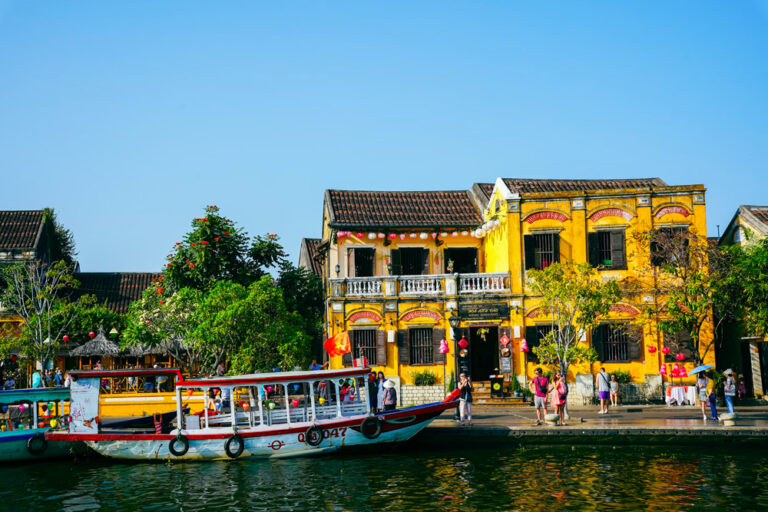
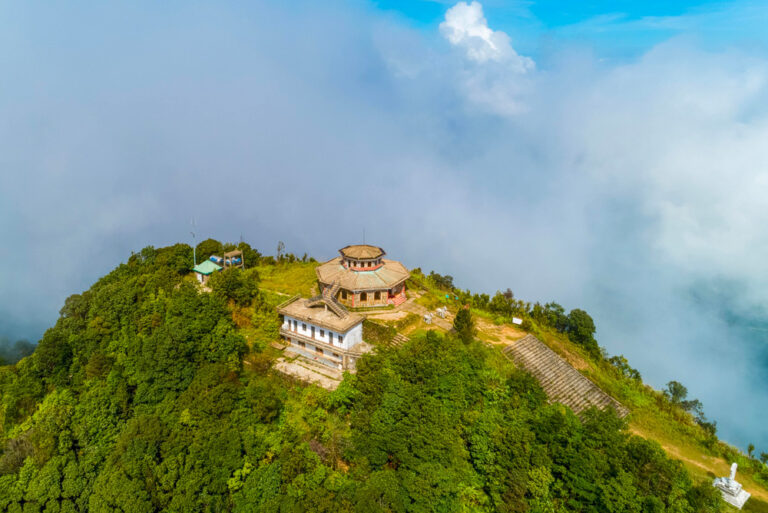



Dear Laurent,
merci and thank you for your efficient and interesting blog – we have had 5 wonderful days in Hoi An and Hué (and travel im between) all based on your recommendations. Bravo! All the best,
Sandra
Hi,
Thank you for your comment and I’m glad my site helped you.
Merci beaucoup pour l’aide ! On arrive a Hanoï dans 3 jours hâte d’y être 🙂
Bonjour,
Vous avez de la chance, le soleil est revenu.
Hello,
We have read your article about the tomb of hue and it’s very interesting.
Do you have a name of a good company to rent a private driver for visiting the tomb ?
Thank you so much for all the article it’s been very helpful so far!
Hi,
I use Hoi An Transport Service ( https://hoiantransportservice.com ), which for me is one of the best private car service companies in the center.